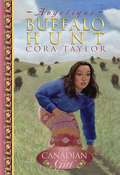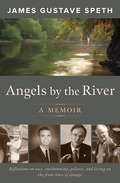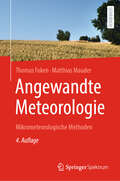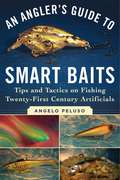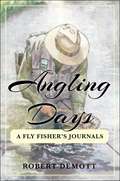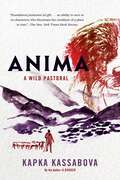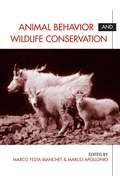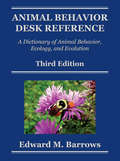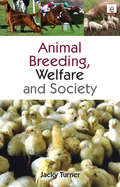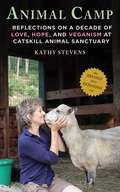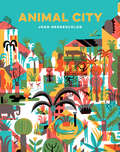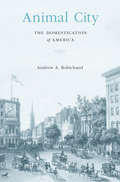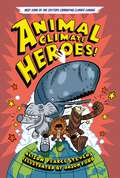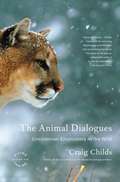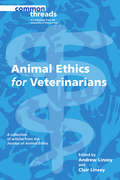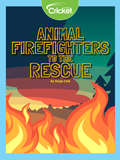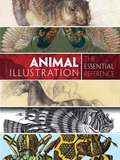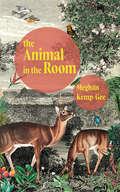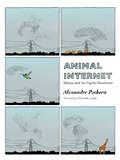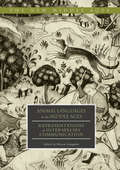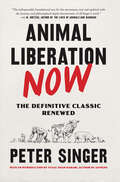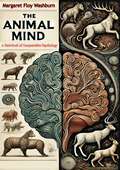- Table View
- List View
Angelique #1: Buffalo Hunt (Our Canadian Girl)
by Cora TaylorBuffalo Hunt is set in the West, during the waning years of the buffalo hunt. Angelique Dumas is a ten-year-old Métis girl, and this year she gets to be part of the hunt-- not with the children, but with the grown-ups.
Angels by the River: A Memoir
by James Gustave SpethAngels by the River follows James Gustave Speth’s unlikely path—from a Southern boyhood to his career as an influential mainstream environmentalist to his current system-changing activism. In this compelling memoir, Speth explores the issues, and realities, that have shaped the nation since the 1950s, and that turned an “ultimate insider” into someone willing to be arrested in front of the White House. Born and raised in a town where both the best and worst of the South shone through—a town that eventually became the scene of South Carolina’s horrific Orangeburg Massacre—Speth explores how the civil rights movement and the South’s agrarian roots influenced his academic career at Yale and later work in the heyday of the environmental movement, when he helped launch two landmark and influential environmental groups—the Natural Resources Defense Council and the World Resources Institute—advise the White House on climate and other emerging issues, and lead the UN’s development efforts around the globe. Speth fought to create and uphold the nation’s toughest environmental laws, but now believes a new environmentalism is needed to confront today’s challenges. The advancing climate crisis cannot be addressed, he warns, as long as we remain fixated on endless growth and consumption, corporate profits, increasing the incomes of the well-to-do, neglecting those just getting by, and helping abroad only modestly. An American tale, in all its complexity, Speth’s memoir is an inspiration—especially for readers contemplating how to make a difference in an increasingly complex world.
Angewandte Meteorologie: Mikrometeorologische Methoden
by Thomas Foken Matthias MauderGegenstand des Buches sind die atmosphärischen Vorgänge im unmittelbaren Lebensraum des Menschen, also in den unteren 100 –1000 Metern der Atmosphäre und in Gebieten mit nur einigen Kilometern Ausdehnung. Dieser mikrometeorologische Raum wird in Büchern der allgemeinen Meteorologie nur wenig berücksichtigt. Damit bietet das Buch Grundlagen insbesondere für angewandte meteorologische Fachgebiete wie Biometeorologie, Agrarmeteorologie, Hydrometeorologie, Umweltmeteorologie und technische Meteorologie sowie für die Biogeochemie. Ein wichtiger Schwerpunkt sind dabei die Transportprozesse und Stoffflüsse zwischen Atmosphäre und Erdoberfläche, wobei bewachsene und heterogene Unterlagen eine besondere Beachtung finden.Die Autoren behandeln die Teilgebiete Theorie, Messtechnik, experimentelle Verfahren und Modellierung so, dass sie jeweils auch eigenständig für Lehre, Forschung und Praxis genutzt werden können.Neuerungen gegenüber der dritten Auflage sind Aktualisierungen und kleinere Ergänzungen in allen Kapiteln sowie ausgewählte inhaltliche Erweiterungen unter Berücksichtigung der Fragen des Klimawandels.
An Angler's Guide to Smart Baits: Tips and Tactics on Fishing Twenty-First Century Artificials
by Angelo Peluso Mark SosinFishing is one of the oldest continually practiced pastimes in history. But like almost everything else in our modern era, it too has been greatly influenced by ever-changing technology and scientific advances. With busy lives, it's often impossible for anglers to keep up with constantly evolving equipment. In An Angler's Guide to Smart Baits: Tips and Tactics on Fishing Twenty-First Century Artificials, veteran fisherman Angelo Peluso helps to navigate these often unsure waters of modern baits and how to fish them. Peluso takes readers through all the essential elements. Among the topics he explains, in depth, are: the appeal and purpose of materials used in modern lure construction, including hi-tech, durable plastics, acrylics and other polymers, and new-age finishes that give impressions of life; the modern science of both hard and soft baits; the sensory appeal of modern baits; and how to maximize a bait?s appeal to yield the most strikes and increase an angler's catch ratios. Including advice and input from expert lure designers, scientists, and manufacturers, An Angler's Guide to Smart Baits is an essential read for every modern fisherman.
Angling Days: A Fly Fisher's Journals
by Robert DeMott“From the very first, it seems, fishing was a respite and a therapy along with all of its other potentially redemptive qualities.” —Robert DeMott Spanning more than forty-five years, Angling Days is a collection of Robert DeMott’s numerous journal entries, each a small essay in itself, jotted down during the placid moments of fishing in and along the streams and rivers of North America. Through his journaling, DeMott carries on the angling tradition of channeling the tranquility of fly fishing into creative endeavors, whether by painting, sketching, fly tying, or writing. For him, it was writing—something he did whenever he could, whether in the midst of fishing or during a break away from the water.Angling Days is a lifetime of work, a chronicle of what it is to be an angler seeking the most pristine waters and the smartest fish. It is a collection of entries and musings in the vein of DeMott’s literary hero, Henry David Thoreau, and promises to shine a new light on the art and joy of fly fishing.
Anima: A Wild Pastoral
by Kapka KassabovaIn Anima, Kapka Kassabova introduces us to the “pastiri” people—the shepherds struggling to hold on to an ancient way of life in which humans and animals exist in profound interdependence. Following her three previous books set in the Balkans, and with an increasinging interest in the degraded state of our planet and culture, Kassabova reaches further into the spirit of place than she ever has before. In this extraordinary portrayal of pastoral life, she investigates the heroic efforts to sustain the oldest surviving breeds of our domesticated animals, and she shows us the epic, orchestrated activity of transhumance—the seasonal movement, on foot, of a vast herd of sheep, working in tandem with dogs. She also becomes more and more attuned to the isolation and sacrifices inherent in the lives shaped by this work.Weaving together lyrical writing about place with a sweeping sense of the traumatic histories that have shaped this mountainous region of Bulgaria, Kassabova shows how environmental change and industrial capitalism are endangering older, sustainable ways of living, and by extension she reveals the limited nature of so much of modern life. But shining through Kassabova’s passionate, intimate response to the monoculture that is “Anthropos” is her indelible portrait of a circulating interdependence of people and animals that might point to a healthier way to live.
Animal Behavior and Wildlife Conservation
by Marco Apollonio Marco Festa-BianchetEfforts to conserve wildlife populations and preserve biological diversity are often hampered by an inadequate understanding of animal behavior. How do animals react to gaps in forested lands, or to sport hunters? Do individual differences--in age, sex, size, past experience--affect how an animal reacts to a given situation? Differences in individual behavior may determine the success or failure of a conservation initiative, yet they are rarely considered when strategies and policies are developed. Animal Behavior and Wildlife Conservation explores how knowledge of animal behavior may help increase the effectiveness of conservation programs. The book brings together conservation biologists, wildlife managers, and academics from around the world to examine the importance of general principles, the role played by specific characteristics of different species, and the importance of considering the behavior of individuals and the strategies they adopt to maximize fitness.Each chapter begins by looking at the theoretical foundations of a topic, and follows with an exploration of its practical implications. A concluding chapter considers possible future contributions of research in animal behavior to wildlife conservation.
Animal Behavior Desk Reference: A Dictionary of Animal Behavior, Ecology, and Evolution, Third Edition
by Edward M. Barrows"Words are our tools, and, as a minimum, we should use clean tools. We should know what we mean and what we do not, and we must forearm ourselves against the traps that language sets us." -- The Need for Precise Terminology, Austin (1957, 7-8) It follows that, for effective and efficient communication, people should have, or at least understand, th
Animal Breeding, Welfare and Society
by Jacky TurnerThe determination of when, how, how often and with whom an animal breeds is moving rapidly away from evolutionary pressures and towards human purposes: these include the breeding of around 50 billion mammals and birds for food production annually, the breeding of pedigree dogs and cats, racing dogs and horses, specialised laboratory animal strains and the use of reproductive science to conserve endangered species or breeds and to limit unwanted populations of pests and non-native species. But the ethics and sustainability of this takeover of animals' reproductive lives have been insufficiently examined by either professionals or the public. This book discusses the methods, the motivations and the consequences of human intervention in animal breeding in terms of animal health, behaviour and well-being. It explores where we are now and the choices ahead, and looks to a future where we have more respect for animals as sentient beings and where we could loosen the reins of reproductive control.
Animal Camp: Reflections on a Decade of Love, Hope, and Veganism at Catskill Animal Sanctuary
by Kathy StevensPicking up where she left off in Where the Blind Horse Sings, Kathy Stevens regales us with more tales of the rescued animals at Catskill Animal Sanctuary (CAS), some touching, some hilarious, all provocative. We meet Barbie, the broiler hen found hiding under a blue Honda in Brooklyn who falls for the animal ambassador Rambo, a ram with an uncanny sense of what others need. Then there's Norma Rae, the turkey rescued from a "turkey bowl" just before Thanksgiving. There's also Noah, a twenty-one-year-old stallion, starved and locked in a dark stall for his entire life until he came to the safety and plenty of CAS. Claude, the giant pink free-range pig, is but another of the "underfoot family," those who roam the barnyard, free and with dignity, interacting with their own and other species in startling and profound ways. The love Stevens has for these animals, and the amount of love they give her in return, is stunning and will make any reader more thoughtful of how we treat a whole class of animals in this country. Pigs, cows, chickens, turkeys, horses, goats, sheep, and more, march into CAS and into our hearts as we learn about their quirks and personalities and what makes us human.
Animal City
by Joan NegrescolorNina journeys to a secret jungle city populated by animals, plants, and lost objects. The reason for her visit: story hour, where a book's power holds the wild in thrall. The animals are eager for stories about space, the sea, and other worlds. But their favorite story of all is the one told here: a story about a mysterious place, laden with legend and lore, and now overtaken by nature. Five Pantone colors infuse each illustrated spread with a vibrant, electric energy, making this powerful celebration of nature—and stories—as vivid visually as its narrative is engrossing.
Animal City: The Domestication of America
by Andrew A. RobichaudAmerican urbanites once lived alongside livestock and beasts of burden. But as cities grew, human–animal relationships changed. The city became a place for pets, not slaughterhouses or working animals. Andrew Robichaud traces the far-reaching consequences of this shift—for urban landscapes, animal- and child-welfare laws, and environmental justice.
Animal Climate Heroes
by Alison Pearce StevensIn our left corner we have the meanest villain that’s ever existed. Responsible for rising seas and loss of biodiversity, it’s climate change ready to wreak havoc on the Earth. But in our right corner? We have four superheroes ready to save the day!Forest elephants protect our forests by trampling trees.Whales boost ocean health with their massive poo-nados.Sea otters defend kelp forests from purple invaders.And echidnas bury tons of soil to stop climate change.But we can’t leave them in this fight alone. We need to protect our heroes who, in return, defend our planet. Get ready to learn all about these four legged, and two-flippered, creatures and how YOU can be a climate hero too!
The Animal Dialogues: Uncommon Encounters in the Wild
by Craig ChildsColorado-based naturalist Childs presents another volume of vignettes, some taken from his 1997 Crossing Paths and other written since then. Each describes an encounter with a non-human animal, among them raccoon, raven, pronghorn antelope, and praying mantis. He has not indexed the collection. Annotation ©2008 Book News, Inc., Portland, OR (booknews.com)
Animal Ethics for Veterinarians (Common Threads)
by Andrew Linzey Clair LinzeyVeterinarians serve on the front lines working to prevent animal suffering and abuse. For centuries, their compassion and expertise have improved the quality of life and death for animals in their care. However, modern interest in animal rights has led more and more people to ask questions about the ethical considerations that lie behind common veterinary practices. This Common Threads volume, drawn from articles originally published in the Journal of Animal Ethics (JAE), offers veterinarians and other interested readers a primer on key issues in the field. Essays in the first section discuss aspects of veterinary oaths, how advances in animal cognition science factor into current ethical debates, and the rise of complementary and alternative veterinary medicine and its relationship to traditional veterinary medicine. The second section continues with an essay that addresses why veterinarians have an obligation to educate animal caregivers to look past "cuteness" in order to treat all animals with dignity. The collection closes with three short sections focusing on animals in farming, trade, and research ”areas where veterinarians encounter conflicts between their job and their duty to advocate and care for animals. Contributors: Judith Benz-Schwarzburg, Vanessa Carli Bones, Grace Clement, Simon Coghlan, Priscilla N. Cohn, Mark J. Estren, Elisa Galgut, Eleonora Gullone, Matthew C. Halteman, Andrew Knight, Drew Leder, Andrew Linzey, Clair Linzey, Kay Peggs, Megan Schommer, Clifford Warwick, and James W. Yeates.
Animal Firefighters to the Rescue
by Sonja ColeClimate change affects many regions with hotter and drier weather, and forest fires are a growing problem. Learn how hungry animals might help reduce wildfires. Fires need fuel, oxygen and heat to start a flame. The forest floors are covered with dry grass, dead wood, and bark called duff–fire fuel! Learn how conservationists are using sheep, goats, beavers and other animals to reduce fires!
The Animal Game
by Daniel E. BenderTracing the global trade and trafficking in animals that supplied U.S. zoos, Daniel Bender shows how Americans learned to view faraway places through the lens of exotic creatures on display. He recounts the public's conflicted relationship with zoos, decried as prisons by activists even as they remain popular centers of education and preservation.
Animal Illustration: The Essential Reference
by Carol Belanger GraftonComprehensive and entertaining, this volume comprises the greatest works in animal illustration from the Middle Ages through the twentieth century. The chronological presentation of hundreds of black-and-white and color images begins with a medieval illuminated manuscript by the Limbourg brothers and the Renaissance works of Albrecht Dürer and other artists from the first centuries of printing. Subsequent illustrations include the seventeenth-century real and imaginary animals of Matthäus Merian and the unique eighteenth-century compilations of Albertus Seba. Nineteenth-century images are drawn from sources as diverse as J. G. Heck's Bilder Atlas; the prints of Georges Baron Cuvier; William Jardine's 40-volume Naturalist's Library; bird illustrations by John James Audubon, Alexander Wilson, Edward Lear, and many others; extraordinary butterfly and insect images by E. A. Seguy, as well as animal illustrations from Victorian chromolithograph die cuts. The exquisite Edwardian bestiary of the Detmold brothers brings the collection into the twentieth century, and ends with the imagery of contemporary dinosaur artist James Gurney.Detailed bibliographical information concerning every source—including biographical details of each artist—makes this collection a vital reference tool as well as a splendid resource of outstanding animal illustrations. Students of graphic art and illustration, as well as graphic designers and advertising professionals, will prize this treasury of material from many rare historic sources.
The Animal in the Room
by Meghan Kemp-GeeLONGLISTED FOR THE GERALD LAMPERT MEMORIAL AWARDDeer with binoculars, wolves with resumes: bioengineered poetry that unsettles truth, fact, and history.Animals are strange testing grounds for thinking about subjectivity, language, the body — really, anything you might want to write a poem about. Together, these poems are an evolutionary chart or a little bestiary – about deer, wolves, evolution, environmental collapse, and extinction. Each one stands alone as a contained organism, but like real animals, they share some genetic material with each other. Considering PTSD and anxiety disorder as a kind of animal experience, a self-protective mechanism, these poems embody the selves we see reflected in the natural world’s creatures. Deer are a way of putting fear and trauma outside yourself, wolves a way to understand the instincts of predators."Oh the pleasure of inhabiting the mind of an animal like Meghan Kemp-Gee! Her poetry is curious, restless, uneasy, and imaginative; it is also highly disciplined, unfolds in precisely measured lines. Watch for brilliant uses of repetition — the slipperiness of meaning, its ever-doubling character, is on full display, played out in deft linguistic twists. A deadpan delivery amplifies the oddity of what’s encountered: arsenic-drunk wildcats, chlorinated orchids, the 'one painful spot of blue' in a deer’s eye. I can’t say strongly enough how grateful I am to have read this collection; don’t miss it." – Sue Sinclair, author of Almost Beauty: New and Selected Poems
Animal Internet: Nature and the Digital Revolution
by Alexander Pschera Elisabeth Lauffer"Animal Internet is a most important book. This excellent work could be a strong catalyst for people to rewild, to reconnect and become re-enchanted with all sorts of mysterious and fascinating animals, both local and distant. By shrinking the world it will bring humans and other animals together in a multitude of ways that only a few years ago were unimaginable."--Marc Bekoff, University of Colorado, author of Rewilding Our Hearts: Building Pathways of Compassion and Coexistence "An original book that goes against the trend to stubbornly keep nature and technology divided from one another."--Der Spiegel "Animal Internet is one of the most interesting books that I've read in recent years."--Bavarian Radio"What Pschera describes sounds futuristic but it's already widespread reality . . . Pschera's book is not just popular science: he describes not only the status quo, but also thinks about an ongoing transformation."--Wired.deSome fifty thousand creatures around the globe--including whales, leopards, flamingoes, bats, and snails--are being equipped with digital tracking devices. The data gathered and studied by major scientific institutes about their behavior will warn us about tsunamis, earthquakes and volcanic eruptions, but also radically transform our relationship to the natural world. With a broad cultural and historical perspective, this book examines human ties with animals, from domestic pets to the soaring popularity of bird watching and kitten images on the web. Will millennia of exploration soon be reduced to experiencing wilderness via smartphone? Contrary to pessimistic fears, author Alexander Pschera sees the Internet as creating a historic opportunity for a new dialogue between man and nature.Foreword by Martin Wikelski, Director, Max Planck Institute for OrnithologyAlexander Pschera, born in 1964, has published several books on the internet and media. He studied German, music, and philosophy at Heidelberg University. He lives near Munich where he writes for the German magazine Cicero as well as for German radio.
Animal Languages in the Middle Ages: Representations of Interspecies Communication (The New Middle Ages)
by Alison LangdonThe essays in this interdisciplinary volume explore language, broadly construed, as part of the continued interrogation of the boundaries of human and nonhuman animals in the Middle Ages. Uniting a diverse set of emerging and established scholars, Animal Languages questions the assumed medieval distinction between humans and other animals. The chapters point to the wealth of non-human communicative and discursive forms through which animals function both as vehicles for human meaning and as agents of their own, demonstrating the significance of human and non-human interaction in medieval texts, particularly for engaging with the Other. The book ultimately considers the ramifications of deconstructing the medieval anthropocentric view of language for the broader question of human singularity.
Animal Liberation Now: The Definitive Classic Renewed
by Peter SingerTHE UPDATED CLASSIC OF THE ANIMAL RIGHTS MOVEMENT, NOW WITH AN INTRODUCTION BY YUVAL NOAH HARARI Few books maintain their relevance—and have remained continuously in print—nearly fifty years after they were first published. Animal Liberation, one of TIME’s “All-TIME 100 Best Nonfiction Books” is one such book. Since its original publication in 1975, this groundbreaking work has awakened millions of people to the existence of "speciesism"—our systematic disregard of nonhuman animals—inspiring a worldwide movement to transform our attitudes to animals and eliminate the cruelty we inflict on them. In Animal Liberation Now, Singer exposes the chilling realities of today's "factory farms" and product-testing procedures, destroying the spurious justifications behind them and showing us just how woefully we have been misled. Now, Singer returns to the major arguments and examples and brings us to the current moment. This edition, revised from top to bottom, covers important reforms in the European Union and in various U.S. states, but on the flip side, Singer shows us the impact of the huge expansion of factory farming due to the exploding demand for animal products in China. Further, meat consumption is taking a toll on the environment, and factory farms pose a profound risk for spreading new viruses even worse than COVID-19. Animal Liberation Now includes alternatives to what has become a profound environmental and social as well as moral issue. An important and persuasive appeal to conscience, fairness, decency, and justice, it is essential reading for the supporter and the skeptic alike.
The Animal Mind a Text-Book of Comparative Psychology
by Margaret Floy Washburn"The Animal Mind: A Text-Book of Comparative Psychology" by Margaret Floy Washburn is a seminal work that offers an in-depth exploration of animal behavior and cognition, bridging the gap between psychology and zoology. As one of the first comprehensive textbooks in the field of comparative psychology, Washburn's groundbreaking work provides valuable insights into the mental processes of various animal species, laying the foundation for future research in animal cognition.Washburn, a pioneering psychologist and the first woman to earn a Ph.D. in psychology in the United States, meticulously examines the sensory experiences, instincts, emotions, and intelligence of animals. Drawing on extensive research and observational studies, she presents a thorough analysis of how animals perceive the world, make decisions, and exhibit behaviors that parallel human psychological processes."The Animal Mind" covers a wide range of topics, including perception, learning, memory, and problem-solving abilities in animals. Washburn's clear and engaging writing style makes complex concepts accessible, while her rigorous scientific approach ensures the reliability and depth of the information presented. Each chapter delves into specific aspects of animal psychology, supported by detailed examples and comparative analyses across different species.Washburn's work is notable for its balanced perspective, considering both experimental data and anecdotal evidence to provide a holistic view of animal minds. She emphasizes the importance of understanding animal behavior not just for its own sake but also for the insights it offers into human psychology and the evolutionary continuity of mental processes."The Animal Mind" is an essential resource for students, researchers, and anyone interested in the study of animal behavior and cognition. Margaret Floy Washburn's pioneering contributions continue to influence the field of comparative psychology, making this textbook a timeless and invaluable reference for understanding the complexities of animal minds and their remarkable similarities to human thought and behavior.
Animal, Mineral, Radical: Essays on Wildlife, Family, and Food
by Bk Loren"Radical, before it meant a person who advocates strong political reform, meant getting to the root of things, the origin. It comes from the Latin radix, radicis,, meaning radish, a root vegetable."-BK LorenThese meditative essays range in subjects from a transcendental encounter with a pack of coyotes ironically juxtaposed with her neighbor's claim that nature "has gone out of vogue," to Loren's mother's slow yet all-encompassing deterioration from Parkinson's, and the unexpected way the Loma Prieta earthquake eroded her depression by offering the author a sense of her small place in a wild and worthwhile world.Loren has an empathetic and gentle approach to the world. In detailing the intricacies of human relationships and consciousness-fear of death and time, cooperation born of clashing viewpoints, tradition's beauty even when destructive, a love of language, a sense of loss amid the fast-paced materialistic world-she peels back the film of popular thinking in order to expose herself to the secrets so few of us ever see.
